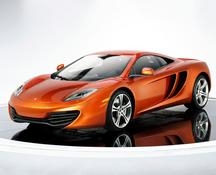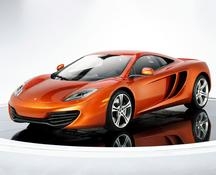
After over 1 million miles of prototype testing, the first new road car from McLaren since 1993 is ready for you. And the first place you can buy one, at about $250,000 a pop, is in mid-2011 at the Auto Gallery store on Wilshire Boulevard in Beverly Hills. (Quite apropos, no?)
The all-new-from-the-ground-up 2012 model, the McLaren MP4-12C, offers 592 horsepower from a new twin-turbo 3.8L 90 degree V8 engine; a nearly-instantaneous paddle shifting system for the seven-speed transmission; a deployable air brake such as you’d find on a fighter jet; brakes which would rival those found on that same jet; looks to kill with single-hinge clam shell doors, full carbon fiber construction and an emphasis on comfort, efficiency and, naturally, outrageous performance.
How demanding and exacting is McLaren? As a shop dedicated to race cars for the past 50 years, all they’re interested in is saving weight (or “adding lightness”) and pushing the envelope, no matter the system or component. Every part on the car, the company says, has been engineered entirely by McLaren, with no outside firms involved.
In fact, in their literature about the 12C, the company makes the case that shifting actually is not near-instantaneous, but flat-out instantaneous, a physical, mechanical and technical impossibility. But they’re happy to make the argument, using their new “pre-cog” technology as a guide to understanding their claim.
It was always a question among analysts of how far McLaren’s target qualities for a race car could be translated into a street car, but 1993’s road-going McLaren F1 model was quickly accepted by zillionaires worldwide as the ultimate supercar. And by more than a few people who actually knew about cars, too.
You may remember it: 240.1 mph, fastest street car ever, carbon fiber build (McLaren hasn’t built a metal-based car since 1983) and it had three seats, with the driver sitting slightly below and in-between the two “rear passengers” to give the pilot the feel of driving a single-seat race car. George Harrison bought one of the first ones, and what more can you say? Performance meets class, efficiency and elegance head-on.
The 12C’s interior is a wonder of current and coming technologies. Just use your voice and the car can figure out where you’re going, almost drive you there, tell you when you’ve arrived and all the while playing whatever audio you prefer; punk rock or rap, or, in the case of this car, perhaps real-time stock quotes.
A hydraulic suspension system has four different condition settings and, McLaren folks emphasized to us, the driver never has to take his or her eyes off the road or fingers off the steering wheel to get from point A to B, swiftly and comfortably.
And as for that air brake? Stab the brakes hard and it shifts the rear wing into a much more vertical position. What the wing now does is force aerodynamic pressure on the rear wheels (“creating downforce” as they say), keeping the rear tires in touch with the road and preventing the rear wheels from locking-up. This means the brakes can do their job without the driver having to worry too much about oversteer (when the rear of the car wants to swap ends with the front; what the NASCAR boys call a “loose” condition).
The UK’s Lotus, Italy’s Ferrari, Germany’s Porsche and Dan Gurney’s Santa Ana-based All-American Eagle shop are some of the racing car-makers which represent not just a particular form of motor racing, but, even to the casual fan or observer, the sport as a whole.
Above them all is McLaren.
Founded by New Zealand-born engineer/driver Bruce McLaren in the early 1960s, it’s the only company to have won championships in Formula 1, LeMans, the Indianapolis 500 (which at one time was part of the World Championship Driving and Constructors’ series) and Can-Am, which was made up of closed-wheel sports cars powered by stock block American-made motors, and according to many (including me) the loudest, ballsiest and most exciting road racing series in history.
McLaren himself was killed while testing a race car, as happened quite often in those days. He was just 32 when his Can-Am car crashed on the Lavant Straight just before Woodcote corner at Goodwood Circuit in England in June, 1970.
He had been testing his new M8D when the rear body work came adrift at speed and all downforce was lost, sending the car airborne. Since then he has been highly-honored and considered one of the top drivers and, especially, driving engineers ever to do duty in the sport.
Beauty as always from McLaren, but now, if you got the kick, the beast too.
Steve Parker is a two-time Emmy Award-winner who has covered the world's auto industry and motor racing for over 35 years. Contact Steve through his own automotive issues website at www.SteveParkerMotoring.com.









